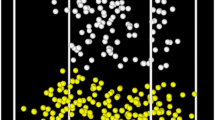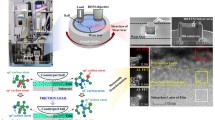Abstract
The atomic-scale processes taking place during the sliding of diamond and diamond-like carbon surfaces are investigated using classical molecular dynamics simulations. During the initial sliding stage, diamond surfaces undergo an amorphization process, while an sp 3 to sp 2 conversion takes place in tetrahedral amorphous carbon (ta-C) and amorphous hydrocarbon (a-C:H) surface layers. Upon separation of the sliding samples, the interface fails. A rather smooth failure occurs for a-C:H, where the hydrogen atoms present in the bulk passivate the chemically active carbon dangling bonds. Conversely, sp-hybridized carbon chains are observed to form on diamond and ta-C surfaces. These carbynoid structures are known to undergo a fast degradation process when in contact with oxygen. Using quantum-accurate density functional theory simulations, we present a possible mechanism for the oxygen-induced degradation of the carbon chains, leading to oxidative wear of the sp phase on diamond and ta-C surfaces upon exposure to air. Oxygen molecules chemisorb on C–C bonds of the chains, triggering the cleavage of the chains through concerted O–O and C–C bond-breaking reactions. A similar reaction caused by adsorption of water molecules on the carbon chains is ruled out on energetic grounds. Further O2 adsorption causes the progressive shortening of the resulting, O-terminated, chain fragments through the same O–O and C–C bond breaking mechanism accompanied by the formation of CO2 molecules.







Similar content being viewed by others
Explore related subjects
Discover the latest articles and news from researchers in related subjects, suggested using machine learning.References
Robbins, M.O., Müser, M.H.: Computer simulations of friction, lubrication, and wear. In Bhushan B. (ed.) Modern Tribology Handbook, pp. 717–765. CRC Press, Boca Raton (2001)
Bowden, F.P., Tabor, D.: The Friction and Lubrication of Solids, 2nd edn. Oxford University Press, Oxford (1950)
Meng, H., Ludema, K.: Wear models and predictive equations: their form and content. Wear 181–183, 443–457 (1995)
Sawyer, W.G., Wahl, K.J.: Accessing inaccessible interfaces: in situ approaches to materials tribology. MRS Bull. 33, 1145–1150 (2008)
Dietzel, D., Ritter, C., Mönninghoff, T., Fuchs, H., Schirmeisen, A., Schwarz, U.D.: Frictional duality observed during nanoparticle sliding. Phys. Rev. Lett. 101, 125505 (2008)
Dienwiebel, M., Verhoeven, G.S., Pradeep, N., Frenken, J.W.M., Heimberg, J.A., Zandbergen, H.W.: Superlubricity of graphite. Phys. Rev. Lett. 92, 126101 (2004)
Bhaskaran, H., Gotsmann, B., Sebastian, A., Drechsler, U., Lantz, M.A., Despont, M., Jaroenapibal, P., Carpick, R.W., Chen, Y., Sridharan, K.: Ultralow nanoscale wear through atom-by-atom attrition in silicon-containing diamond-like carbon. Nat. Nanotechnol. 5, 181 (2010)
Gotsmann, B., Lantz, M.A.: Atomistic wear in a single asperity sliding contact. Phys. Rev. Lett. 101, 125501 (2008)
Archard, J.F., Hirst, W.: The wear of metals under unlubricated conditions. Proc. R. Soc. Lond. A 236, 397–410 (1956)
Quinn, T.F.J., Sullivan, J.L., Rowson, D.M.: Origins and development of oxidational wear at low ambient temperatures. Wear 94, 175–191 (1984)
Morita, T., Banshoya, K., Tsutsumoto, T., Murase, Y.: Corrosive-wear characteristics of diamond-coated cemented carbide tools. J. Wood Sci. 45, 463–469 (1999)
Chang, H.W., Rusnak, R.M.: Contribution of oxidation to the wear of carbon–carbon composites. Carbon 16, 309–312 (1978)
Gouider, M., Berthier, Y., Jacquemard, P., Rousseau, B., Bonnamy, S., Estrade-Szwarckopf, H.: Mass spectrometry during C/C composite friction: carbon oxidation associated with high friction coefficient and high wear rate. Wear 256, 1082–1087 (2004)
Kasem, H., Bonnamy, S., Rousseau, B., Estrade-Szwarckopf, H., Berthier, Y., Jacquemard, P.: Interdependence between wear process, size of detached particles and CO2 production during carbon/carbon composite friction. Wear 263, 1220–1229 (2007)
McKee, D.W., Savage, R.H.: Chemical factors in carbon brush wear. Wear 22, 193–214 (1972)
Pastewka, L., Moser, S., Gumbsch, P., Moseler, M.: Anisotropic mechanical amorphization drives wear in diamond. Nat. Mater. 10, 34–38 (2011)
Kim, S.: Synthesis and structural analysis of one-dimensional sp-hybridized carbon chain molecules. Angew. Chem. Int. Ed. 48, 7740–7743 (2009)
Whittaker, A.G.: Carbyne forms of carbon: evidence for their existence. Science 229, 485–486 (1985)
Casari, C., Li Bassi, A., Ravagnan, L., Siviero, F., Lenardi, C., Piseri, P., Bongiorno, G., Bottani, C.E., Milani, P.: Chemical and thermal stability of carbyne-like structures in cluster-assembled carbon films. Phys. Rev. B 69, 075422 (2004)
Casari, C., Libassi, A., Ravagnan, L., Siviero, F., Lenardi, C., Barborini, E., Piseri, P., Milani, P., Bottani, C.: Gas exposure and thermal stability of linear carbon chains in nanostructured carbon films investigated by in situ Raman spectroscopy. Carbon 42, 1103–1106 (2004)
Hitchiner, M.P., Wilks, E.M., Wilks, J.: The polishing of diamond and diamond composite materials. Wear 94, 103–120 (1984)
Pastewka, L., Moser, S., Moseler, M.: Atomistic insights into the running-in, lubrication, and failure of hydrogenated diamond-like carbon coatings. Tribol. Lett. 39, 49–61 (2010)
Pastewka, L., Moser, S., Moseler, M., Blug, B., Meier, S., Hollstein, T., Gumbsch, P.: The running-in of amorphous hydrocarbon tribocoatings: a comparison between experiment and molecular dynamics simulations. Int. J. Mater. Res. 99, 1136–1143 (2008)
Peters, E.A.J.F.: Elimination of time step effects in DPD. Europhys. Lett. 66, 311–317 (2004)
Hird, J.R., Field, J.E.: Diamond polishing. Proc. R. Soc. A Math. Phys. 460, 3547–3568 (2004)
Pastewka, L., Pou, P., Prez, R., Gumbsch, P., Moseler, M.: Describing bond-breaking processes by reactive potentials: importance of an environment-dependent interaction range. Phys. Rev. B 78, 78–81 (2008)
Colombi Ciacchi, L., Payne, M.C.: First-principles molecular-dynamics study of native oxide growth on Si(001). Phys. Rev. Lett. 95, 196101 (2005)
Carbogno, C., Behler, J., Gross, A., Reuter, K.: Fingerprints for spin-selection rules in the interaction dynamics of O2 at Al(111). Phys. Rev. Lett. 101, 096104 (2008)
Mortensen, J.J., Hansen, L.B., Jacobsen, K.W.: A real-space grid implementation of the Projector Augmented Wave method. Phys. Rev. B 71, 035109 (2005)
Enkovaara, J., Rostgaard, C., Mortensen, J. J., Chen, J., Dulak, M., Ferrighi, L., Gavnholt, J., Glinsvad, C., Haikola, V., Hansen, H.A., Kristoffersen, H.H., Kuisma, M., Larsen, A.H., Lehtovaara, L., Ljungberg, M., Lopez-Acevedo, O., Moses, P.G., Ojanen, J., Olsen, T., Petzold, V., Romero, N.A., Stausholm-Moller, J., Strange, M., Tritsaris, G.A., Vanin, M., Walter, M., Hammer, B., Häkkinen, H., Madsen, G.K.H., Nieminen, R.M., Norskov, J.K., Puska, M., Rantala, T.T., Schiotz, J., Thygesen, K.S., Jacobsen, K.W.: Electronic structure calculations with GPAW: a real-space implementation of the projector augmented-wave method. J. Phys. Condens. Matter 22, 253202 (2010)
Perdew, J.P., Burke, K., Ernzerhof, M.: Generalized gradient approximation made simple. Phys. Rev. Lett. 77, 3865–3868 (1996)
Bitzek, E., Koskinen, P., Gähler, F., Moseler, M., Gumbsch, P.: Structural relaxation made simple. Phys. Rev. Lett. 97, 170201 (2006)
Tang, W., Sanville, E., Henkelman, G.: A grid-based Bader analysis algorithm without lattice bias. J. Phys. Condens. Matter 21, 084204 (2009)
Henkelman, G., Jónsson, H.: Improved tangent estimate in the nudged elastic band method for finding minimum energy paths and saddle points. J. Chem. Phys. 113, 9978 (2000)
Landman, U., Luedtke, W.D., Burnham, N.A., Colton, R.J.: Atomistic mechanisms and dynamics of adhesion, nanoindentation, and fracture. Science 248, 454–461 (1990)
Ravagnan, L., Siviero, F., Lenardi, C., Piseri, P., Barborini, E., Milani, P., Casari, C.S., Li Bassi, A., Bottani, C.E.: Cluster-beam deposition and in situ characterization of carbyne-rich carbon films. Phys. Rev. Lett. 89, 285506 (2002)
Sowa, M.B., Anderson, S.L.: Oxidation of small carbon cluster ions by O2: effects of structure on the reaction mechanism. J. Chem. Phys. 97, 9164 (1992)
Gu, X., Kaiser, R.I., Mebel, A.M.: Chemistry of energetically activated cumulenes—from allene (H2CCCH2) to hexapentaene (H2CCCCCCH2). ChemPhysChem 9, 350–369 (2008)
Ravagnan, L., Manini, N., Cinquanta, E., Onida, G., Sangalli, D., Motta, C., Devetta, M., Bordoni, A., Piseri, P., Milani, P.: Effect of axial torsion on sp carbon atomic wires. Phys. Rev. Lett. 102, 245502 (2009)
Heimann, R., Kleiman, J.: A unified structural approach to linear carbon polytypes. Nature 306, 164 (1983)
Moras, G., Pastewka, L., Walter, M., Schnagl, J., Gumbsch, P., Moseler, M.: Progressive shortening of sp-hybridized carbon chains through oxygen-induced cleavage. Submitted (2011)
Zakharchenko, K.V., Fasolino, A., Los, J.H., Katsnelson, M.I.: Melting of graphene: from two to one dimension. J. Phys. Condens. Matter 23, 202202 (2011)
Kim, S.G., Tománek, D.: Melting the fullerenes: a molecular dynamics study. Phys. Rev. Lett. 72, 2418–2421 (1994)
Ohnishi, H., Kondo, Y., Takayanagi, K.: Quantized conductance through individual rows of suspended gold atoms. Nature 395, 780–783 (1998)
Yanson, A.I., Bollinger, G.R., van den Brom, H.E., Agraït, N., van Ruitenbeek, J.M.: Formation and manipulation of a metallic wire of single gold atoms. Nature 395, 783–785 (1998)
Chang, H.W.: Correlation of wear with oxidation of carbon–carbon composites. Wear 80, 7–14 (1982)
Acknowledgements
We are grateful to Michael Walter and Johann Schnagl for helpful discussions. We acknowledge financial support from the German Federal Ministry of Education and Research (BMBF grant 03X2512G), from the German Federal Ministry of Economics and Technology (BMWi grant 0327499A), and from the European Commission (Marie-Curie International Outgoing Fellowship for L.P.). The simulations were carried out on computer facilities at Fraunhofer IWM and JSC Jülich.
Author information
Authors and Affiliations
Corresponding author
Rights and permissions
About this article
Cite this article
Moras, G., Pastewka, L., Gumbsch, P. et al. Formation and Oxidation of Linear Carbon Chains and Their Role in the Wear of Carbon Materials. Tribol Lett 44, 355 (2011). https://doi.org/10.1007/s11249-011-9864-9
Received:
Accepted:
Published:
DOI: https://doi.org/10.1007/s11249-011-9864-9
Keywords
Profiles
- Lars Pastewka View author profile




